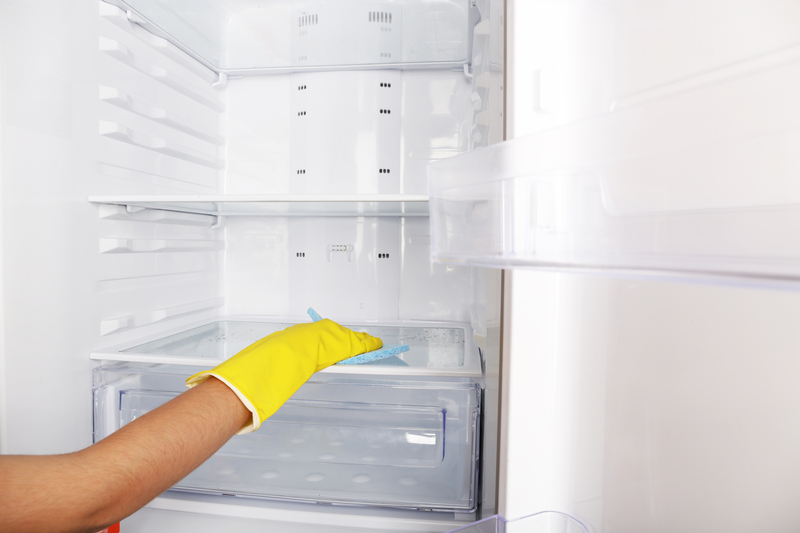Crystal Clear Solution: Cleaning Mould from Window Sills
Posted on 21/08/2025
Crystal Clear Solution: Cleaning Mould from Window Sills
Are unsightly patches of mould making your window sills look shabby and posing health risks in your home? Cleaning mould from window sills is essential not only for the beauty of your living space but also for maintaining a healthy indoor environment. This comprehensive guide will offer you a crystal clear solution to eradicate mould from your window frames and sills efficiently, while ensuring it doesn't make a quick return.

Understanding the Menace: Why Does Mould Grow on Window Sills?
Mould is a cunning invader that thrives in damp, poorly-ventilated environments. Window sills are common hotspots because they're often exposed to condensation, leaks, or trapped humidity. Understanding why mould breeds in such areas is the first step in effectively removing mould from your window sills and preventing future infestations.
- Condensation: Cool surfaces meet warm, moist indoor air, leading to water droplets on glass and sills.
- Leaky windows: Water infiltration from damaged seals or frames creates perfect mould habitats.
- Poor ventilation: Limited airflow allows excess moisture to maintain high humidity.
- Organic debris: Dust, dirt, and plant material supply nutrients for mould growth.
Health Hazards of Mould on Window Sills
The presence of mould on window sills is more than an aesthetic issue. It poses genuine health risks, especially to sensitive individuals:
- Aggravation of allergies and asthma
- Respiratory issues
- Eye, nose, and throat irritation
- Potential for infections in immunocompromised people
Keeping your window area free of mould is essential for a healthy home.
Preparation: Safety First Before Cleaning Mould from Window Sills
Before tackling the job, ensure your safety and protect your home environment. Mould spores can become airborne during cleaning, so don't skip these precautions:
- Wear protective gloves to avoid direct skin contact with mould or cleaning chemicals.
- Use an N95 respirator mask to avoid inhaling spores.
- Don safety goggles to protect your eyes.
- Open windows for adequate ventilation, or use a fan to direct air outside.
- Cover nearby surfaces or furniture to shield them from potential spatter.
Essential Tools and Supplies for Mould Removal
- ✅ White vinegar - Excellent for killing a broad spectrum of mould types.
- ✅ Bicarbonate of soda (baking soda) - Perfect for scrubbing and deodorising.
- ✅ Commercial mould remover (optional) - For especially stubborn infestations.
- ✅ Microfiber cloths or paper towels for gentle cleaning.
- ✅ Scrub brush or old toothbrush for tough spots.
- ✅ Spray bottle for applying cleaning solutions.
- ✅ Warm water for rinsing residue.
How to Clean Mould from Window Sills: Step-By-Step Process
1. Assess the Extent of the Mould Growth
Inspect the entire window sill, including corners and the underside. If you encounter extensive black mould (covering more than a square meter), consult a professional. For small to moderate spots, proceed with these cleaning methods.
2. Dry Out the Area
Mould won't grow without moisture. If the sill is wet, dry it using towels or a portable fan before beginning your cleaning process.
3. Remove Surface Debris
- Use a vacuum with a HEPA filter or a microfiber cloth to collect dust, dirt, and loose spores.
- Dispose of the vacuum bag or cloth promptly.
4. Apply Your Cleaning Solution
- White vinegar: Pour undiluted vinegar into a spray bottle and saturate the mouldy areas. Allow to sit for at least 60 minutes.
- Bicarbonate of soda: Mix 1 teaspoon with 2 cups water. Spray or dab onto remaining stains after initial cleaning for stubborn marks.
- Commercial mould cleaner: Follow manufacturer's instructions carefully for best results.
5. Scrub the Sill
Using a scrub brush or old toothbrush, gently work away the loosened mould. Focus on crevices and corners where spores may lurk.
6. Wipe Clean and Rinse
- Wipe down the entire window sill with clean, damp microfiber cloths.
- For heavy infestation, repeat the cleaning process until the mould is gone.
- Dry the sill thoroughly to prevent future growth.
7. Dispose of Cleaning Materials Safely
- Seal contaminated clothes, paper towels, or vacuum bags in a plastic bag before discarding.
- Launder used cleaning cloths in hot water and dry thoroughly.
Natural Alternatives for Cleaning Mould from Window Sills
If you prefer chemical-free cleaning, the following natural remedies are excellent for removing mould from window frames and sills:
- Lemon juice: The natural acidity helps break down mould stains and leaves a pleasant scent.
- Hydrogen peroxide (3%): Effective for killing mould spores. Spray, let sit for 10 minutes, then scrub and wipe away.
- Tea tree oil solution: Mix 1 teaspoon in a cup of water, spray, and allow to sit. Wipe clean for long-lasting protection.
Prevention Tips: Stop Mould from Returning to Your Window Sills
- Ensure adequate ventilation: Open windows regularly, use exhaust fans, or run dehumidifiers in high-moisture rooms.
- Fix leaks promptly: Repair window seals, flashing, or caulking to prevent water intrusion.
- Wipe away condensation frequently, especially on cold mornings or after storms.
- Keep window sills clean and dry by dusting and wiping down often.
- Consider using anti-mould paint or treatment on window frames in chronic problem areas.
- Trim plants outside windows to improve air circulation and reduce humidity.
When to Seek Professional Help for Mould on Window Sills
While most small mould patches can be managed with DIY solutions, there are situations when professional intervention is essential:
- Mould covers a large area: Over 1 square meter.
- You experience persistent allergic or respiratory symptoms despite cleaning.
- There's extensive black mould (Stachybotrys chartarum), which may indicate deeper moisture problems.
- Mould returns rapidly after repeated cleaning.
Professionals can assess moisture issues, perform deep cleaning, and repair structural problems for lasting results.
The Importance of Regular Maintenance
Vigilance is key in preventing mould build-up on window sills and frames. Follow a regular maintenance routine:
- Inspect window sills monthly for early signs of mould.
- Clean window sills and tracks as part of your regular housekeeping.
- Monitor humidity levels: Keep indoor relative humidity below 60%.
The Eco-Friendly Approach: Safe Disposal and Cleaning Practices
When cleaning mould from your window frames, protect your family and environment by disposing of contaminated materials responsibly. Use eco-friendly cleaning agents, avoid excessive bleach (which can harm both surfaces and air quality), and ventilate the space well.

FAQ: Your Top Questions About Cleaning Mould from Window Sills
How often should I clean my window sills to prevent mould?
Ideally, wipe your window sills every week and do a thorough inspection and cleaning monthly, particularly during humid seasons.
Is bleach a good solution for mould on window sills?
While bleach can kill superficial mould, it doesn't penetrate porous materials and may leave spores alive beneath the surface. Opt for vinegar, hydrogen peroxide, or commercial mould removers for better results.
What's the best way to keep window sills dry?
- Wipe away moisture daily.
- Improve ventilation.
- Use dehumidifiers if your home is prone to dampness.
Can mould on window frames or sills damage my property?
Yes, prolonged exposure to moisture and mould can damage paint, wood, or uPVC surfaces, potentially necessitating repairs or replacement if left untreated.
Conclusion: Achieving Crystal Clear and Healthy Window Sills
A sparkling, mould-free window sill not only enhances the look of your home but contributes to a healthier living environment. By following these crystal clear cleaning methods and prevention tips, you can say goodbye to mould, protect your family's health, and prolong the life of your windows. Remember, the earlier you tackle mould, the easier it is to remove - so stay vigilant, keep your home ventilated and dry, and enjoy your clean, bright window sills for years to come!
For more expert tips on home cleaning and maintenance, bookmark this guide and share it with fellow homeowners - because a healthy home is a happy home!




